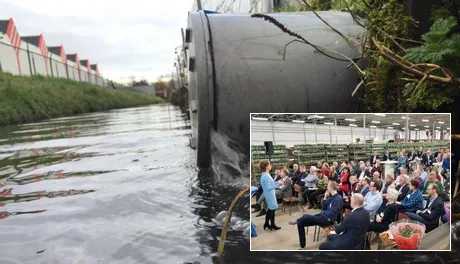The water quality in the greenhouse horticulture areas in the management area of Delfland in the Netherlands shows positive developments in 2018 once more: a decrease in fertilizers and crop protection residues has been noted in recent measurements. This is good news for everyone using the land, the Delfland water board says. “Because clean water is something we can all benefit from, even the greenhouse horticultural sector itself.”

Less fertilizer use means less chance of duckweed in the Schie, de Vliet, and other waters. Fewer pesticides in the water mean that, for greenhouse horticulture, more allowed products for pest control remain.
Grade presentation
Under the watchful eye of many interested parties, Ingrid ter Woorst of the water board presented the results of the measurements of the water quality in 2018 on Thursday the 7th of March. These showed that the positive trend of nitrogen that was apparent in the previous years has continued in 2018. The amount of crop protection products found has decreased. The concentration of detected substances has however increased slightly in comparison to last year. But the concentration of nitrogen and pesticides do both meet the amount given by the achievement indicators for 2018.
Ter Woorst: “It was pretty close though, since 2018 had been an exceptional year due to the drought, luckily it looks positive now. We are headed in the right direction, not just because of the water quality norms we have to meet, but because, in the end, clean and healthy water is important to everyone. We have a common goal: for us because of the water quality and the greenhouse horticultural sector because of the admission policy, fair competition, and sustainable image.”
According to Ter Woorst, the good results are mainly due to the intensive cooperation of all the partners: industry association Glastuinbouw Nederland, the crop protection manufacturers united under Nefyto and also the cooperation with the greenhouse horticulture entrepreneurs themselves. “Among others, this is also due to the location-based approach, in which we intensely monitor all greenhouse horticulture polders and together with entrepreneurs find solutions to their problems. But we need to stay alert. Because, unfortunately, we notice that if we were to leave one of these polders the attention to these problems decreases and some entrepreneurs end up making similar mistakes again.”
Jacco Vooijs and Theo Ammerlaan, presidents of Greenhouse Horticulture Westland and Eastland respectively, are also happy with the results. Vooijs: “The current approach is working. The entrepreneurs are becoming more and more aware of the water. The drought of 2018 has also contributed to this: as fresh water is no longer taken for granted, it has become necessary to be more conservative with it.
I am happy that both the regional water authorities and the entrepreneurs make an effort to find innovative ways to reuse as much fresh water as they can. Pollution with pesticides and fertilizers simply doesn’t fall in line with this idea. I hope that the next lecture from Delfland also sees that the current intensive approach is paying off and that the collaboration in all areas is being continued.”
Source: Water Board of Delfland
